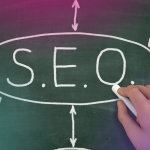Last Updated on 2nd January 2024
Providing Website Customers With Good User Experience
The development of digital media across multi-channel platforms enable brands to enhance user experience. Yet many online businesses concentrate on the product rather than the customer.
Improving website user experience should be a fundamental part of conversion rate optimisation.
As the Internet of Things moves swiftly towards omni-channel experiences, there are more ways than ever for brands to connect with customers. But at the same time, the virtual reality of online domains can mean businesses can become disconnected from their customers.
It is become equally important therefore that brands create a good user–experience regardless of the platform or stage of the purchasing process. UX may be driven by design, but it is more than just an interface.
Team game
Once upon a time, digital marketing was about specialist knowledge. Whilst little has changed in this respect, there is no room for individualism. Digital marketing is a team game for team players.
User experience is about the relationship your customers have with technology and it is the role of the digital marketing team to identify and design that relationship. UX is about human-computer interaction and understanding how your user thinks and feels as they traverse through each step of your platform.
Whilst a content marketer and a web developer may face different challenges, they both have to work towards the same goal of the strategy – which means sitting down together to map the path and plant the flowers. They need to understand how to lay an information scent for the website visitor and signpost the way so the needs of your audience are met in both sub-tasks and tasks (micro and macro goals).
But don’t forget about the seeds that will fall out along the way. The sales team and customer service team also need to be aligned with the digital marketing team to enable them to deliver a prompt and personal response to customers. The team also need to be watching constantly to identify parts of the path which may be broken and identify just what went wrong so that customers and prospects alike can be shown the right way again.
UX and Mobile-First
Mobile-first is a total game-changer for UX, particularly since, as organic-search focused marketers we no longer have the luxury of being able to present lighter content on a mobile device to users and still rank based on the desktop equivalent. Google calls for content-parity now, since both mobile and desktop will be ranked on the content delivered to mobile–users.
Google recently shared (accidentally) a series of UX Playbooks across a number of verticals. To be clear, these were not intended to indicate you’d somehow rank better in organic search and have since been confirmed as designed for the paid search arena. However, we can take some very strong cues as to what Google considers ‘best in class’ for UX across the various niches. These UX playbooks covered several areas including retail, lead generation, travel and more. Across the various playbooks a clear theme runs through. Findability and ease of use are key above the fold. Unsurprising given the very little amount of space available on mobile devices.

Changing technology
Technology has changed the marketing landscape dramatically in a short space of time, and UX revolves around the device they are using to access your site, read about your products and above all make the purchase.
The purchasing path is therefore getting longer and the range of flowers broader. Online marketing is not about promoting a product, but how you engage with your customers and how easy you make the purchasing process.
According to a study conducted salesforce.com, 91% of consumers say they want to be able to access content by whatever means possible. Tablets are the preferred choice at present followed by smartphones.
But with the continuing emergence of wearable tech, marketers have another way of interacting with customers. In the near future, fibre technology could be so advanced that companies can offer profound virtual experiences that are a close second to reality.
More than a message
Online marketing involves more than delivering a message. The demands and expectations of consumers are focused on the customer service you offer and how easy you make the purchasing process.
Essentially, consumers want to feel important and be assured that the product they are buying will change their life in the way you tell them it will. In other words, you need to hold their hand and guide them safely along the garden path.
As technology develops there is a greater need for companies to bond cross-departmental processes otherwise the overall customers experience is not cohesive and you could suffer from loss of sales.
You can’t promise a spectacular water fountain then push your customer in the rose garden!
Website Usability Issues That Lose Customers
User-experience is a major issue for consumers and online business owners. If customers cannot find want they are looking for quickly and easily, they will leave your website and look elsewhere. That’s likely to be your competitors, since the need of your users didn’t change – only their opinion on what they found when they got to your site (or didn’t find).
To avoid missing out on a sale and the potential to build a loyal customer base, ensure your website is user-friendly across multiple devices.
Here is our top five key usability issues that will lose you customers.
Load times
Forget content, speed is king. End-users typically give websites 2-10 seconds (depending which report you read), before clicking out. Don’t risk losing customers for the sake of a few snazzy features on your website.
Although HTML5 and fast internet connections have improved load times, you still risk slowing your site speed down by loading it up with weighty files such as videos, high pixelated images and heavy javascript codes.
Signposts
Another bug bear with consumers is not being able to find what they want in a hurry, and not knowing where to go next. Visitors need clear instructions to navigate your site so guide them through every step of the purchasing path.
You can add signposts through navigation menus and sub-menus, embedding internal links within blog content and web copy, call to action buttons and by making best use of the footer by including links to your primary and sub-services.
Easy interaction
The quality of a users experience rests on how easy it is to use your website. Try to keep scrolling to limit, and eliminate users having to scroll both horizontally and vertically.
Busy websites will not win you any likes from shoppers, so keep content to a minimum and highlight new or discounted products and/or branded content.
The purchasing process should be simple and achievable in as few a clicks as possible. Try to void having to make customers fill out lengthy forms.
Be mobile friendly
There are more searches performed on mobile devices than laptops these days. Responsive web designs have partly solved the problem of usability, but an all-round mobile friendly design is a priority.
Not only can load speeds and navigation pose issues for mobile users, but if your website is not optimised for mobiles they also struggle to perform actions. Use tidy menus and large call to action buttons that are usable on mobile phones.
Pop up ads
This could be a contentious addition for some marketers and web owners, but we’re throwing it in anyway, namely because consumers find “traditional banner advertising distracting and will actively avoid sites.” (Digital News Report)
Consumers find banner ads annoying, especially when the advertisement is not what they are looking for at that moment. 31% of UK internet users are put off by banner ads and look elsewhere. As consumers begin to lose patience with traditional advertising, this figure is likely to get bigger. With this in mind, Google have also implemented a ‘interstitial penalty’ on mobile devices which downgrades sites covering the main content of their web pages in search results. The user coming from search never bought into the content that you’re covering the screen with and invested their click through in something you’re actually hiding from them almost completely. Naturally, is is a very annoying experience and Google realised that. It should be noted that this ‘interstitial penalty’ is not applicable for desktop sites, but you might want to test to see whether it is actually still annoying users. Alternatively consider an exit-intent sign-up. Again, you might even find that this annoys users to the point of no-return.
User-experience (UX) is one of the – if not THE – most important aspects of your website. Without solid information architecture users can easily navigate, don’t expect visitors to hang around.
Yet a quarterly 2016 Digital Trends report compiled by eConsultancy and Adobe revealed only 22% of business respondents planned to focus on optimising customer experience that year.
Could that be a mistake? Well not really.
The top priority for marketers is to focus on the individual experience through multi-channel platforms and across several devices. Content, social media engagement and personalisation all top the agenda.
And this is why the separate departments of your digital marketing team need close communication.
How important is user-experience?
UX is HUGE.
Given the marketing efforts of competitors in every industry and the number of devices customers use to access the web, if you are not better than your rivals on multiple channels, how do you expect to make a profit from your online business?
If a visitor to your website cannot find what they want – even when you have it – they will leave your website and go to your rivals!
But in order to do that across the board, every member of your digital marketing team has to understand who your customer is, what they want, and how you will get it to them.
So how do you get the information to them, fast, efficient and smoothly?
How to create a better user-experience
User-experience breaks down to two fundamental parts; 1. How easily a customer can get access to your product and information about your product and,
2. How you make customers feel about your product
Let’s tackle the first issue:
Your website has to be quick, and it has to be navigable. You need fast load times and a sitemap that does not make the user ask, “now what do I do?” If a visitor has to think about their next move, you fail!
The second point is solved by building trust between you and your prospects. And here is the cruncher. To earn the trust of visitors to your site, the UX has to be spot on – and that means right across the board.
So UX is a team effort, and that means bringing the best creative minds in your business together in order to brainstorm which design and content ideas will create the best UX across multi-channel platforms and devices.
Testing is creating
The UX of your online business should not stop with your creative team of designers, developers and content curators. Use other members of your team to test how user-friendly the end result is and tweak out the nooks and crannies.
Feedback from an independent pair of fresh eyes is just as valuable as the original idea. Testers often see things the creator misses. When you work on a project for a long time it is easy to miss something.
Furthermore, inviting fringe members of your team to get involved with important projects is good for office morale. If everybody feels they are contributing something, there is a stronger sense of achievement throughout the office and just not within a core group of creators.
You could say that creating a good user-experience starts with creating a good creative experience. It’s a team effort and working in a team is much more satisfying than working in partitioned cubicles.
5 Quick Fixes To Improve User Experience

Google is all for user-experience right now – especially for mobile shoppers. But as a dedicated webmasters you should be considering the usability of your website on multiple platforms.
When trying to map out the usability of a website in your head, you might think your brain will explode. It’s pretty difficult to see without the visual aid of live screening. So what do you instruct your web designer and content writers?
Here are a few things you should focus on when endeavouring to improve the user-experience of your website.
Easy to navigate
Navigation should be at the very top of your bucket list. If visitors cannot easily find what they are looking for they will leave and go to a rival site.
The information architecture of your site is an all-important aspect of online success and is proven to increase traffic and conversions.
When planning the orientation of your website, remember that visitors are accessing your content on a variety of different devices which have different sized screens.
We will assume you have a responsive web design already, and if not get one asap other you will not rank in Google.
What you have to do now is consider how mobile users will navigate your site compared to desktop users with a 20-inch plus screen.
Write scannable content
On the subject of usability on various screen sizes, written content plays a major role. A short paragraph on a desktop screen could filter into an entire chunk of text on a 5-inch landscape.
Large chunks of text look cumbersome and put people off reading. Furthermore, online users do not have the time or patience to actually read. They typically scan – so use bite-sized paras and regular headings.
Find and fix broken links
In relation to navigation, links play an important role. They need to work. If you have redesigned your site and shifted a few pages, go through your copy and check links are still directing to relevant content.
Broken links go against your credibility as a website with customers and search engines downgrade pages containing links that lead nowhere.
If you have a lot of content you might want to consider investing in a tool to help you find missing links.
Load speeds
Research shows that mobile users will only wait a maximum of four seconds for a website to upload. Some won’t even hang around that long. Fast load speeds are therefore critical.
The time it takes a webpage to load up depends on the weight of data. A quick fix is to compress and scale your images before loading them to your site. This means less work for your server and quicker load times.
Don’t make visitors think
The modern consumer does not want difficult choices to make, nor do they want to have to think about what to do next. They need pointing in the right direction. Some gentle persuasion doesn’t hurt either.
This is where your call-to-actions come in. Whenever the purchasing process requires taking in more information from another page, guide prospects to it by signposting “more information” and providing the link.
Modern online users expect to enjoy a good experience when they visit a website. They do not have the time or the patience to battle with a poorly planned website.
UX in Footers
The purpose of a website is to communicate your brand, product and services to customers. And to do that, you should be using as much retail landscape as possible without overcrowding screens.
It’s surprising how many companies do not make good use of the footer space. Granted, there are a limited number of options for design at the bottom of the screen, but utilising this space is essential to your overall information architecture.
How you make best use of the footer will largely depend on the type of business you are and how many services you offer. But the important thing is, you don’t let the space go to waste.
Call to action
The most popular, and arguably the most effective use of footer real estate is planting your call to action. The bottom of the page is as good a place as any to prompt customers to move on to the next step.
The majority of firms use the footer to include their address and other contact details. Whilst this information is important, a call to action giving customers a reason to contact you is often overlooked.
Navigation
Online businesses that have a wide range of products and services to offer can make best use of their web design by listing everything they do at the foot of the page.
Everything you include in dropdown menu at the top of the page can be laid out in an at-a-glance overview in the footer. This makes navigation convenient for users and prompts them to take the next step of the purchasing process.
Testimonials
Customer testimonials give prospects confidence, and all too often you find them squeezed into the sidebars or have an entire page dedicated to them. Okay, that last option is not a bad idea, but nor is using the space at the foot of every page.
Advertise USP
A unique selling point you want to highlight can be brought to the attention of prospects at the very last drop of content. If you have strong sales copy that intrigues and excites a prospect, the USP at the bottom of the page might just be the clincher that helps them make up their mind.
Examples of USP’s in footers are exclamations such as 10% of your first purchase, or free delivery on orders of £50.
How you use the footer space should not be underestimated. It could be the difference between a sale and a fail.
By making the user-experience of your online business a priority, you will increase your credibility, improve traffic and search engine rankings. Most of all you will improve conversion rate.
If usability is not at the top of your to-do list, make a new list. A poorly designed website that does not provide a good user-experience will severely damage your online business. You won’t get any customers.












